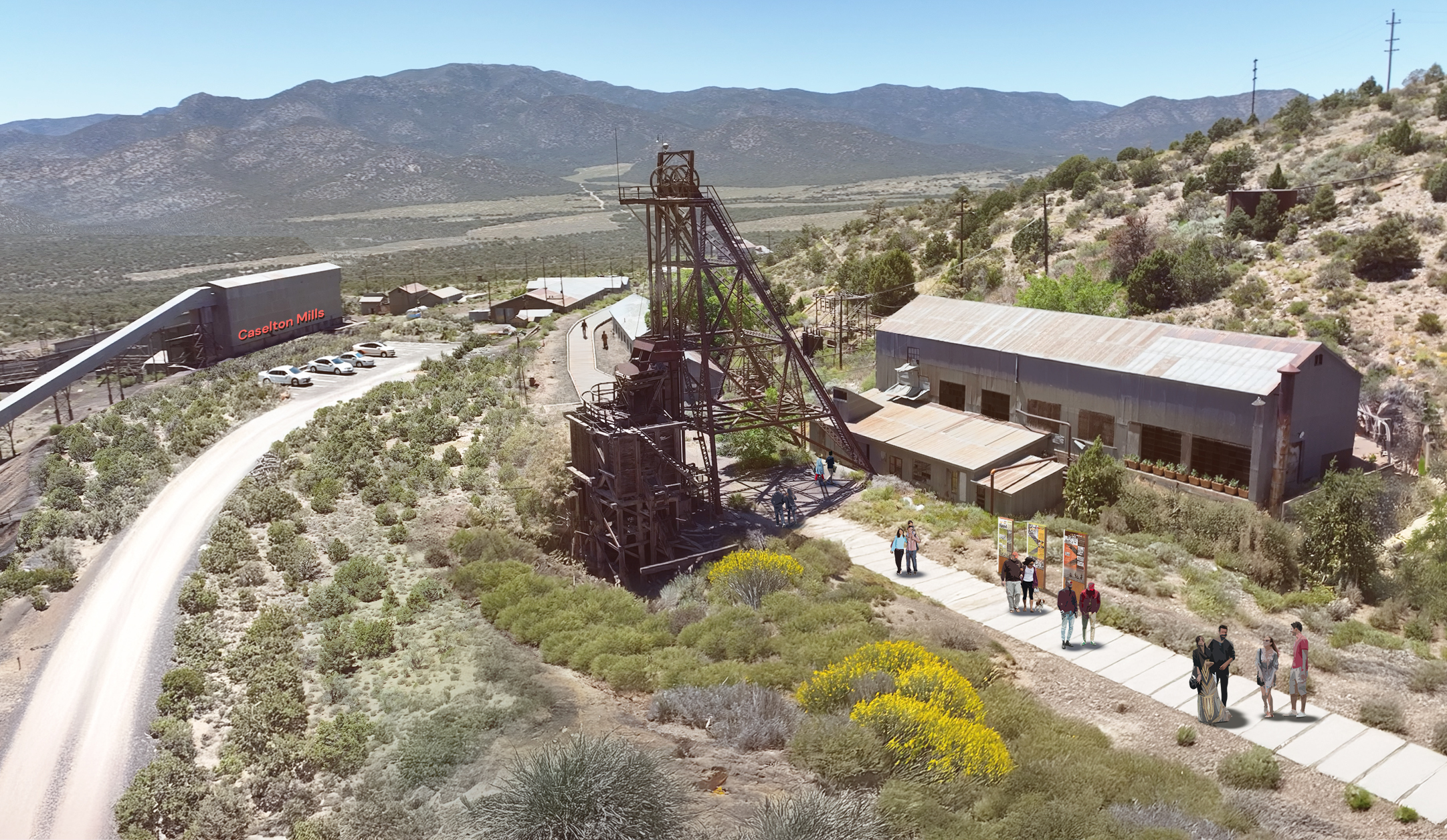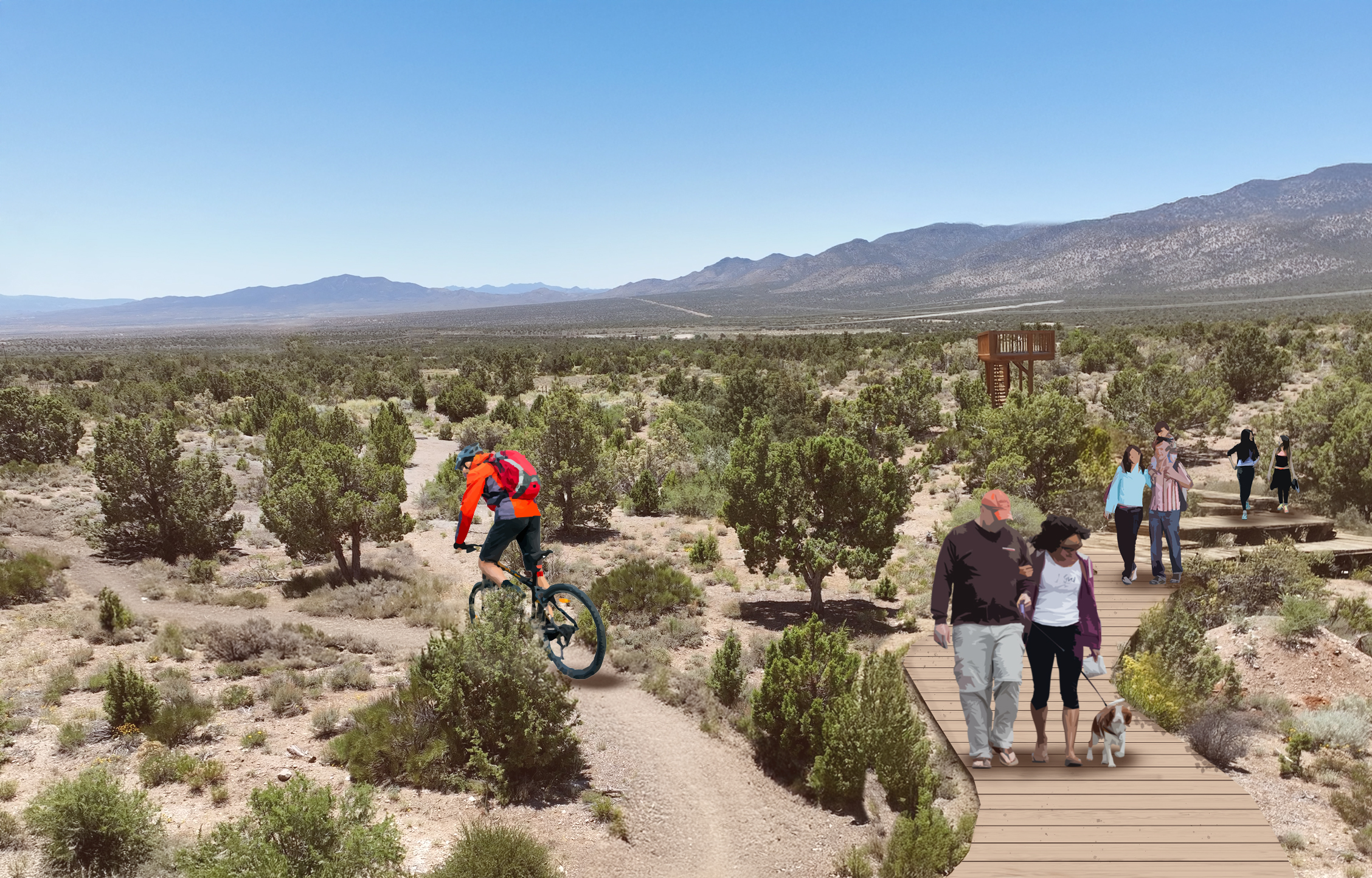
CCLR and Partners Receive EPA Award for Community Solar Planning in Nevada
EPA’s Office of Land and Emergency Management has recognized CCLR and its partners with a National Notable Achievement Award for the Caselton Mill Vision to Action plan. In 2024, CCLR and our partners: Lincoln County, The Nature Conservancy (TNC), ICF, Nevada Division of Environmental Protection (NDEP), Greenfield Multistate Trust, Lincoln County Power District and EPA conducted community visioning in Pioche Nevada to identify reuse potential of an abandoned mine and mill site in Lincoln County, Nevada. The site has historical significance to the community and is a visual reminder of the region’s rich mining history. However, residual contamination is a road block to reuse of the site.

Site assessment involves considering local topography, vegetation and habitation (for humans and local wildlife). Image Credit: ICF.
The community received support from an EPA Targeted Brownfield Assessment (TBA) at the site. While the assessment was ongoing, Lincoln County and NDEP asked CCLR to assist with redevelopment planning. Community-scale solar of 2-10 megawatts was identified early on as a potential end use for the site to address community energy needs. However, the need for local, affordable electricity easily could have clashed with the desire to protect viewsheds, preserve historic structures, and create new recreation opportunities. CCLR’s planning expertise helped navigate these conflicting interests to develop an actionable redevelopment plan that satisfied all community priorities for the mill and mine site.

Current site conditions at the Castelton Mill site.
CCLR organized two community planning events called Vision to Action workshops. The first workshop, held in June 2024, focused on what the community wanted to see the site used for. The second workshop, hosted in September 2024, showcased proposed designs based on the end uses identified in the first workshop and collecting feedback to create a final plan, which was published later that month. The final Vision to Action Plan includes a step-by-step guide for community leaders to advance the redevelopment of the site.

A map to outline the mill site and potential re-use options. Image Credit: ICF.
Four key themes were identified at the first workshop for end use of the site: solar energy, historic preservation, tourism and recreation. The community also provided preferences for the level of intensity of each theme. For example, 86% of residents supported solar on the site, but that number dropped down to 50% if panels obstructed the beautiful mountain and valley views residents enjoy. Residents placed dots on a printed map of the site to highlight which viewsheds should be preserved, helping CCLR prioritize the location of photovoltaic panels to deliver electricity without interfering with the scenic vistas.
Concerns about site contamination were raised at both workshops. Community members were concerned about toxic dust blowing from the site towards homes, exposure for future visitors hiking and biking on the site, and concerns for how to protect solar workers both during the construction and ongoing support of the proposed solar array. These concerns were addressed during the V2A process, showcasing how human health can be protected on idled mine brownfield sites.
The V2A process also showcased how support of solar energy can conflict with a desire to not see panels from one’s own home. These view considerations are widespread and not limited to Lincoln County, NV. Ultimately, the size of the solar project was scaled down to satisfy the residents’ desire to protect views.

Renderings of a pedestrian path and parking area. Image Credit: ICF
CCLR partner ICF recommended the solar array be placed on the southwestern edge of the site, which sits at a lower elevation than the nearby community of Caselton Heights. The ICF design team also made recommendations for vegetation to screen the panels even further from residents. These mitigations illustrate that balance can be found between energy needs and view protections, but will require a higher number of smaller-scale projects to meet demands.

Renderings of a pedestrian path and bike trail. Image Credit: ICF
A lot of work still needs to be done in order to realize the community’s vision at the Caselton Mill. First, assessment and cleanup work must be completed to ensure the health of residents, visitors, and solar workers are protected now and into the future. Secondly, the site will need to be rezoned to support the preferred end uses and funding will need to be secured to develop trails, historical signage, parking and restore the mill for use as a museum. A phased approach was recommended to keep project momentum, opening the site to tourism sooner and adding additional amenities, such as the museum, down the road. Additionally, the viability of community solar may be impacted by the early termination of federal solar tax credits. This swift shift in incentives showcases how national politics can impact community-led redevelopment efforts, and clash with local needs.
CCLR will continue to support Lincoln County through these steps. We thank the EPA for recognizing the planning efforts for this brownfield redevelopment project. We are grateful to our federal, state and local partners for supporting the Caselton Mill project. Most of all, we are thankful to the residents of Pioche and Caselton Heights who graciously donated their time and shared their visions for the future of the site. We hope that vision can be transformed into action that creates a site the community will be proud to show off for generations to come.


